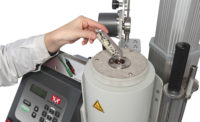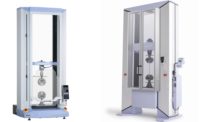It’s important to understand the types of testing that goes into creating the end products we use every day: from the plastic that is designed into cars, to bottles that hold our water, to the equipment used in various sports. Plastics, or thermoplastic materials, are processed as fluids under the effect of temperature and pressure. They can be formed into a wide variety of shapes and tailored for many different applications by means of molding, extrusion, and blowing techniques. However, their flow properties during these processes are complex and affected by many parameters. For this reason it is important to characterize materials and fully understand their rheological properties.
Rheology is a multi-disciplinary science that incorporates fundamental physics and chemistry, as well as many facets of materials engineering. These relationships are so strong that the explanation and prediction of rheological properties is based on knowledge of molecular structure and fundamental laws of physics.
Thermoplastics, i.e. polymers, are long-chain molecules and their structure influences all their mechanical, chemical, and rheological properties. By increasing the molecular weight distribution, the mechanical properties, such as strength or fatigue resistance, chemical properties, and rheological properties, such as the melt viscosity, increase too. Indeed, higher molecular weight distribution means that more entanglements are in the microstructure. While better chemical properties and stronger mechanical properties are good for some applications, the corresponding increase in melt viscosity means that higher pressure is required to extrude the molten polymers. This consequently may lead to more issues during end-product production. Rheological measurements are essential for material characterization when studying or monitoring the conversion of thermoplastics from pellets (raw material) to finished parts.
TECH TIPSConsumers rely heavily on many plastic products in their daily lives. Given their high expectations for durability and aesthetics, it’s become apparent that rheology testing is a necessity for plastics manufacturers. Rheology is a multi-disciplinary science that incorporates fundamental physics and chemistry, as well as many facets of materials engineering. |
Types of Testers
There are two types of instruments used to measure the rheological properties of plastics: melt flow testers and rheometers.
A melt flow test determines the flow properties of a polymer melt or similar material, following the main international standards ISO 1133 and ASTM D1238. Typically, a few grams of a thermoplastic sample are heated and compacted inside a furnace, becoming a homogeneous fluid. A constant load is then applied, pushing the material out through a capillary die. The melt flow rate (MFR) is the quantity of the sample that flows out in a defined period of time, traditionally expressed in grams per 10 minutes.
Capillary rheometers, which characterize viscosity and other rheological properties of molten polymers, are described by the main international standards ISO 11443 and ASTM D3835. They simulate process conditions and investigate the flow behaviors of thermoplastics as a function of temperature and flow speed. A certain quantity of thermoplastic sample is compacted inside a heated barrel, becoming a homogeneous fluid. The molten sample is then forced through a capillary die of known dimensions while pressure is exerted on it by a piston. The test pressure is normally measured via a pressure transducer close to the die entrance. One test normally includes a series of different piston speeds at a controlled temperature and shows how shear stress (proportional to the steady-state pressure at a certain speed) changes as a function of shear rate (speed of shear deformation). The typical result is the rheological curve that plots viscosity versus shear rate.
Applications
For quality control, Melt Flow Rate (MFR) and Melt Volume Rate (MVR) are important properties to check the quality of the raw material. However, there are times when this type of test does not provide sufficient information. Unknown issues with materials and processes can cause a range of problems on the production floor, from stopping production due to high pressure through to defects on the molded parts. With the development of new products and increasing time-to-market demands, there is a need to prevent these problems before they occur in production. It is when companies, such as the one discussed in the following example, encounter such issues, that they realize the need for implementing a different approach to testing: an approach that utilizes rheology testing.
A producer of car components was creating their product using a filled polycarbonate via an injection molding process. This company used to perform only an MFR test on incoming material using a simple melt flow tester. During production, they found many of the finished parts had surface defects. Since the aesthetics of the component was the most important feature, the company began facing issues with its customers, losing money and reputation in the process. As they investigated the cause, the company understood a deeper analysis of the material was necessary before its use in production. A melt flow tester was not enough, simply because the flow conditions of the material during production are affected by many factors. In this particular case, the speed of injecting the material into the mold is higher than the speed of flow involved in a MFR test. This company was able to use a capillary rheometer to change and test various process parameters until they found the ideal conditions for their materials. Then these changes were implemented on the production line, resulting in consistent and high quality components.
The Need for Rheology
Rheological tests make it possible to simulate processing conditions with various combinations of deformation speeds and temperatures. In an extruder, a constant temperature is maintained but the speed changes due to the different rotational screw speed along the barrel. In injection molding, both the temperature and speed change along the barrel length, since the screw acts as a piston by quickly injecting the material into the mold. By performing a rheological test it is possible to set a temperature and measure the viscosity at different speeds of deformation.
In R&D, capillary rheometers have the capability to provide additional information about molten polymer behavior. This is possible due to the availability of optional accessories and software features that enhance the testing capabilities of the rheometer.
Instability of a test may be caused by a number of factors including the nature of the sample, test temperature, capillary geometry, pressure, and extrusion speed. Processing the material under unstable conditions will generate problems, such as a change in the extruded filament geometry (producing helical, rather than smooth, finish). So, it is vital for the lab operator to understand those conditions in order to better define the most suitable processing range.
Extrudate swell is a typical phenomenon observed in fluids having a viscous-elastic or non-Newtonian behavior. Even under steady-state conditions, the flow generates normal stresses that are perpendicular to the direction of the flow itself. These are released at the die exit, causing the extrudate to swell or enlarge its diameter. Quantifying this swell helps manufacturers to understand whether their process conditions will produce components that have the proper dimensions.
Some polymers are used to produce films. By utilizing the capillary rheometer (beside standard viscosity measurements) with a stretching device, it is possible to investigate the drawing capabilities of a sample, measuring the ultimate drawing speed and force reached when the strand finally breaks. These drawing tests, also known as melt stretching tests or haul-off tests, reproduce processing conditions found in blow molding, film blowing, and other processes where the material undergoes mechanical (tensile) stresses while cooling after extrusion.
Consumers rely heavily on many plastic products in their daily lives. Given their high expectations for durability and aesthetics, it’s become apparent that rheology testing is a necessity for plastics manufacturers.





